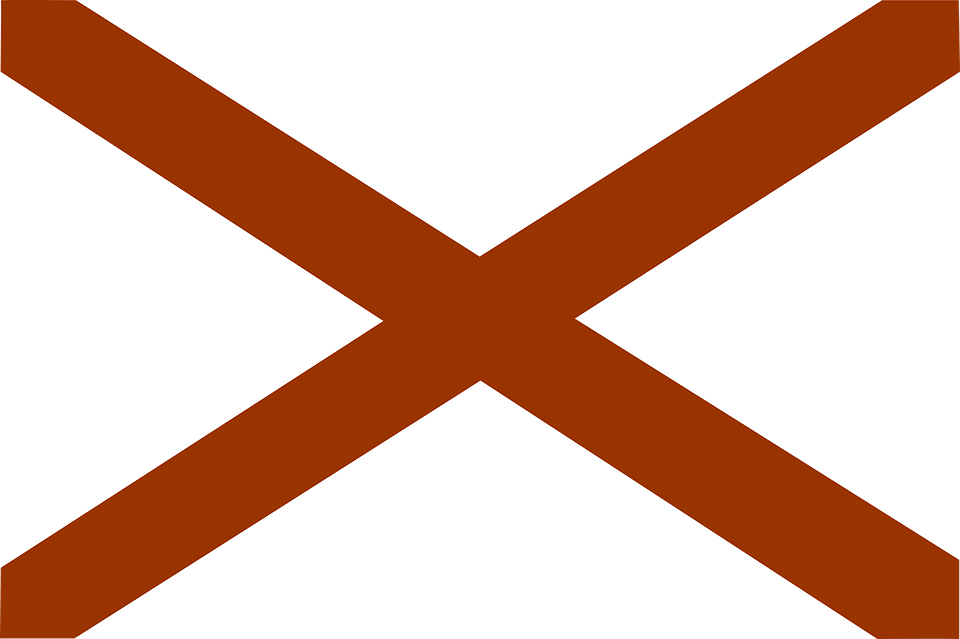
With natural gifts like deciduous forest, rolling hills, coastal lowlands, estuaries, bike paths, great beaches, wonderful summers and snowy winters to offer in the realm of aesthetics, Rhode Island is also a meeting point of nonconformist currents and important rebellions and layers and layers of cultures. Both nature and culture have sketched their instructive marks in the identity of Rhode Island, and the Rhode Island flag is an attempt to picturize this legacy. In this article we will take a brief look at the development of the flag and spend some time with the symbolism to better understand the evolution that took Rhode Island where it is and the cultural weight the celebrated ‘Ocean State’ carries.
History of the flag
The present Rhode Island flag was incorporated by the state’s General Assembly in 1897 and is based on a design by the founders, Anne Hutchinson and Roger Williams. Williams was permitted through a Royal Charter to employ the Anchor design as his own seal in 1644. He contributed the word “Hope” to the anchor seal which he had used as the primary flag of the State of Rhode Island and Providence Plantations, established in 1636. This is still the state’s name in the official records. The white and blue colors of the flag pay tribute to flags hoisted by numerous military regiments throughout far stretches of history like the Revolutionary War, the War of 1812, and the Mexican War.
The anchor has been applied as a token for Rhode Island since the colony’s establishment in 1636, which is quite some time before its attainment of Statehood. The most consistent explication concerning the use of “Hope” reaches us from the notes of Howard M. Chapin who published an important work titled Illustrations Of The Seals, Arms And Flags Of Rhode Island. Upon pages numbered 4 and 5, he theorized that iconography of the seal probably drew inspiration from the biblical phrase borne in Hebrews, in Chapter 6, in verses 18 and 19.
Rhode Island’s very first nonmilitary state flag was incorporated on March 30, 1877. Its white background referred to the facings on military uniforms dawned during the Revolution. The Rhode Island flag’s anchor and motto were carved in Rococo style and circled by blue stars symbolising the count of states in the Union. Upon February 1, 1882, the Rhode Island flag was modified to a simpler design—a blue field with an anchor of yellow encircled by a ring of 13 yellow stars, signifying the rank of the state among those ratifying the U.S. Constitution. On May 19, 1897, the current Rhode Island flag was incorporated.
Symbolism of the Rhode Island flag
The Rhode Island flag, the narrowest among all state flags of the US with a length to breadth ratio of 29:33, sports a white background with a golden and blue emblem positioned upon the centre. The emblem houses a ship anchor, painted in gold, hedged round by thirteen golden stars. Underneath the anchor, and on the inside of the circle bearing the stars lies a blue banner with golden writing that runs, “Hope.” The thirteen stars symbolise the original thirteen colonies along with Rhode Island’s position as the thirteenth state to ratify the constitution. The anchor is an early Christian symbol of hope and harks back to the biblical quotation: “hope we have as an anchor of the soul,” and pays tribute to the founding fathers of the state who were staunch Christians.
We may now try to examine the reason for the incorporation of oceanic and sea-faring images in the state seal, and in sequence, evaluate the cultural charge focused on the imagery to this day.
Oceanic environment of Rhodes Island
Lying in the far north east of the USA, a significant portion of the state is influenced by the Atlantic Ocean and the multiple waterways of Rhode Island which feed into it. Rhode Island boasts more than 400 miles of coastline and one of the most striking geographical features of Rhode Island is Narragansett Bay which is located a little off the east coast of the state and serves as home to more than 30 islands.
Historical heritage of the Ocean
The history of Rhode Island is rich with contributions from and the influences of in the vast blue stretches of the Ocean. Narragansett Bay housed half a dozen small harbours and river mouths that were congenial for the construction and despatch of ships and the docking of vessels run by merchants. A massive portion of the early dividends earned in Rhode Island were pivoted on shipbuilding and even today, businesses based on military shipbuilding remain a significant chunk of the economy.
By the end of the colonial era, Rhode Island had evolved a steady commerce with the entire Atlantic community, including England, the Portuguese islands, Africa, South America, the West Indies, and other British colonies. Though agriculture happened to be the dominant occupation, commercial activities flourished in Newport, Providence, and Bristol and in less prominent ports like Wickford, Westerly, Warren etc.
The Malevolent Side of the Coin
The most profitable yet dark aspect of this boom was the slave trade. The merchants of Rhode Island exceeded those of any other colony in this regard. This traffic formed one aspect of a triangle shaped route, fetching molasses from the West Indies to Rhode Island, whose distilleries made it into rum. This liquor was distributed along the African coast for slaves, who were carried in claustrophobic, pest-ridden ships to the West Indies, the Southern colonies, or back home for domestic service in the merchant mansions or the plantations.
Current Influence of Oceans
The Blue Economy comprises all resources, arising from the ocean. It’s projected to increase twofold from $1.5 trillion to $3 trillion by 2030. Rhode Island’s Narragansett Bay is the Center of Excellence for the Blue Economy. Providence, another preeminent place in the state, is thought to be a world leader at applying advances in research and technology across all sectors of this economy. The host of activities is anchored in Rhode Island by potential or emerging projects like a shipping industry of global standards, renewable energy harvesting projects like Deepwater Wind, construction of large commercial seaports, boating competitions and tourism with international appeal, academic researches into oceanography etc.
These brushstrokes, then, offer us a coincidental insight into the economic and secular cultural evolution and relevance of the ship anchor symbolism found in the state seal.
About the state seal
At the Rhode Island State House, in the heart of the floor, lies a brass replica of the State Seal, grafted into the marble. A garland of leaves circles the shield which carries the anchor and around it all are the words “Seal of the State of Rhode Island and Providence Plantations 1636.” The state seal has been adopted by consecutive Rhode Island government authorities since the year 1644.
Observations About The Flag
Its arrangement of colours is not the standard practice because yellow on white is very difficult to spot clearly, especially when the flag is flying or seen under dimly lit situations.
About Rhode Island
Rhode Island was one of the original 13 states and stands as one of the six New England states. It is flanked to the north and east by Massachusetts, to the southern direction by Rhode Island Sound and Block Island Sound of the Atlantic and to the west by the state of Connecticut. It is the smallest state in the country but certainly one of the most densely populated. Rhode Island’s deep connection to the sea—represented in about 400 miles (640 km) of coastline—is the reason of its nickname, the Ocean State. The capital of this state is Providence. The naming of this state was done by Dutch explorer Adrian Block. He named it “Roodt Eylandt” meaning “red island” for the red clay that lined and formed the shore. The name was later modified into an anglicist form when the place came under British rule.
Another instructive historical nickname, Southern Gateway of New England, was given to Rhode Island because the state was the most southerly of the New England states with harbours suitable for ships sailing out for commercial purposes. These harbours enabled New England raw materials and finished goods to be transported to other parts of the United States and foreign countries and promoted processed and finished material from other parts of the United States and foreign countries to be brought to New England. Another popular nickname for Rhode Island, evidently with reference to the state’s tiny size is ‘Little Rhodie”. Rhode Island is the smallest in size among the 50 states in the area.
Rhode Island was founded by Roger Williams in 1636, who had been removed from the Massachusetts colony for his support of religious tolerance and the separation of powers of church and state. Rhode Island was among the first and most energetic colonies to resist British rule, having been the first to arrange a continental congress in 1774 and in 1776, in order to oppose an oath of allegiance to the British that had been mandatory for colonial officials. Energetic entrepreneurship and innovations transfigured Rhode Island’s economy from seaborne commerce to heavy industry, and the state was leading at the head of the Industrial Revolution in the United States.
Rhode Island also houses an important Native American heritage. When the first European settlers landed, the main tribes in Rhode Island were the Narragansett and Wampanoag. The State Archives enlists a great many land deals between indigenous people of the area and colonists. As colonial settlements expanded, the General Assembly began to limit important sustenance activities of the local tribe. Tensions escalated and ended in the outbreak of King Philip’s War in 1675.
King Philip’s war permanently changed the character Rhode Island. Thousands of native peoples were slaughtered; most survivors deserted the area or were captured and sold to labour as slaves. One hundred years later, during the American Revolution, the General Assembly sanctioned a regiment to be constituting African American and Native American men. Enslaved men who enlisted were given their freedom at the end of the war.
Rhode Island is an attractive place with beaches and fresh-from-the-ocean seafood. It’s also a melting pot of public art, stylish mansions, beautiful villages, and flaming rivers along with its local farms, brews and winding trails. It’s artistic in expression, rebellious in legacy, historic and modern in appearance, welcoming in its spirit, and diverse in its constitution.
By: Srijani Das



